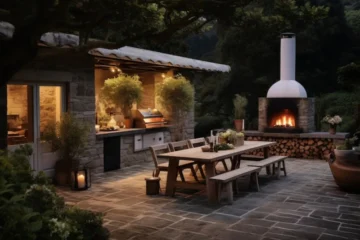Introduction
Concrete countertops have rapidly grown from a niche application to a popular fixture in modern kitchens and baths. But while their practicality and sleekness carry definite curb appeal, some argue concrete’s full potential remains to be tapped when we limit ourselves to traditional shapes and standard looks.
This guide encourages digging into more profound and challenging assumptions about what defines a countertop surface. Concrete grants us creative license, after all. The mix awaits only your ingenuity to transform lifeless slabs into interactive art pieces reflecting style and personality. Why treat your countertop as merely a functional plane? You can craft a statement showpiece that sparks joy and wonder for years to come through strategically embedded accents, bold geometry, eclectic textures, and more.
Breaking Traditional Boundaries
Most homeowners opt for the familiar L-shaped arrangement when planning new counters, which allows efficient food prep workflows. But don’t let conventional wisdom steer you from exploring more daring designs if the space allows. Remember—concrete adapts easily to diverse configurations.
Custom Shapes and Forms
Today’s flexible molds permit sculpting concrete into smooth curves, tapered edges, or unique footprints tailored to your taste. Cabinetry cutouts accommodate these novel overhangs or non-straight runs effortlessly. Complement interesting base shapes with attention-grabbing surface variations like contour drops.
Beyond Rectangles
Alternatively, retain a modular layout but introduce geometric patterns that add intrigue, like hexagonal, triangular, oval, or diamond-segmented designs. Contrast the custom forms against uniform cabinet facades for added impact. Mix and match edge styles between sections for further dynamism—bullnose meeting chamfered meeting rounded.
Customizing Color Palettes
While grayscale concrete exudes refined elegance, skillful manipulation of color through integrated pigments and stains grants unlimited options for infusing personality. Don’t be afraid to explore bold and muted hues to enliven your counters.
Unique Color Schemes
When ordering concrete counter supplies, specify a signature color upfront when ordering premixed countertop concrete, or stir directly in liquid/powder admixtures for greater control. Layer contrasting shades at boundaries for striking combinations like jet black meeting rich gold. Tint only the bottom lift for a showstopping reveal. Be adventurous.
Artistic Effects through Blending
For more seamless, artisanal results, gradually transition between companion hues by misting and feathering secondary colors into the wet first pour using small spray bottles. Skim later batches atop previously hardened layers to intermingle unique grains for dimensional patterns resembling natural stone. Allow randomness to delight.
Incorporating Embedded Elements
Examining a cross-section of natural rock formations reveals a captivating heterogeneous blend of materials interfused by immense pressures over millennia. Recreate organic intrigue in your counters by thoughtfully embedding mementos and found objects.
Adding Personal Touches
Introduce treasured items like coins, porcelain shards, marbles, or sea glass into mold cavities before pouring concrete to showcase them on your finished surface. Position inclusions both deeply and barely protruding to mimic natural layering. Imprint fabric patterns, lace, or leaves for an ethereal effect post-demolding. Make it meaningful.
Ensuring Structural Longevity
While most small embedded materials pose no compromise to surface strength, consider positioning more substantial objects like large rocks or metal scraps away from high-stress areas where loads concentrate to avoid eventual cracking. If you are concerned about inclusions, consider wire-reinforcing around them. Allow the concrete to be fully cured before excessive loading.
Texture Play
Beyond colors, concrete’s malleable nature creates opportunities for applying varied textural finishes, adding visual allure and tactile delight—smooth as polished stone for some areas and heavily sandy for contrast elsewhere. Think beyond mere visual depth by embracing concrete’s multifaceted nature.
Smooth, Satin, or Rough?
Playing with the ratio of fine/coarse aggregates during mixing yields counters with glassy sheen or rougher grittiness. Introduce pressed molds for uniform indentations. Wire brush or chisel partially cured sections for random, craggy effects. Acid etching opens surface pores for increased grip. Consider durability and cleaning when finishing.
Textural Accents
Reserve intense finishes for selective areas, not entire installations. Designating a single-ragged strip bordering uniform countertops makes for attractive relief without sacrificing function. Highlight islands by topping them with inlaid metal grillwork or intricate tile mosaics—surprise guests by juxtaposing matte and glossy sections.
Mix Media Magic
While concrete alone allows stunning outcomes, introducing supplemental materials like wood, metal, or recycled glass greatly multiplies aesthetic possibilities. Blend textures and colors for counters with captivating visual depth and personality. Feel free to get creative with components.
Mixed Media Inspiration
Wood introduces welcome warmth, whether framing edges with exotic lumber or embedding live-edge river slabs. Contrast this organic look by lining the same surface with sleek stainless steel tooling or worn patina copper sheets. Crushed auto glass, tumbled gemstones, and found objects also shine embedded judiciously.
Design Considerations
When integrating multiple media, consider material differences in expansion coefficients and water permeability (for outdoor installations). Adhesives and sealants compatible with both components ensure durable cohesion. Precision digital templates assist in transferring eclectic inlays during forming. Feel empowered designing a true showpiece.
The Art of Inlay
Inlays—set-in designs contrasting the primary concrete material—have been used by artisans for millennia to dazzling effect. Intricate patterns, symbols, and material medleys capture viewers’ imaginations. Advancements in CNC cutting technology now facilitate detailed inlay work within reach of home crafters.
Inlay Inspiration
Not restricted to simple geometric forms, inlays may display fluid curves, nature motifs, foreign scripts, and more. Match different hardwoods and recycled metals to blend subtly or boldly, announcing their presence. Allow your culture and interests to steer the aesthetic—nautical, bohemian, and Art Deco flavors abound.
Executing Your Vision
Having finalized an inlay design, transfer the silhouette to substrate material (wood, tile, etc.) for precision cutting by CNC router. After demolding cured concrete, route acceptor pockets per the dimensions of your custom inlay pieces using a template guide. Fitting together, the finished puzzle transforms the concrete surface beautifully.
Interactive Design Elements
Technology allows concrete counters to transcend static surfaces and enable responsive features, making everyday living more convenient and playful. Embed displays and sensors change the space dynamically. Future-proof your investment with forward-thinking functionality.
Integrated Technology
Thin-profile touchscreens that are flush mounted enable controlling home systems or displaying digital art without cluttering the aesthetic. Creative types may embed LED lighting underneath translucent counters to emit customizable colored ambiance synchronizing with music or mood. Motion sensors could illuminate drawers when hands approach or auto-lift adjustable kitchen islands.
Smart Construction
Rather than drill vulnerable portals post-installation, use conduit sleeves to waterproof cabling for electrified or electronic components during the pour stage. Position in strategic locations able to link power and data sources nearby. Adhere to electrical codes and concrete additive ratios to maintain curing. Think ahead.
Sustainability in Design
With environmental responsibility no longer an afterthought for consumers, approaches that conserve resources and renew waste enjoy increasing demand from eco-conscious homeowners—factor sustainability from the earliest planning stages.
Eco-Conscious Materials
Specifying concrete mixes incorporating substantial shares of industrial byproducts and recycled waste minimizes landfill overflow and boosts vibrant mottling. Investigate locally sourced aggregates and renewable plant-based chemical admixtures to calculate the lowest carbon footprint. Every small decision aids the planet.
Reducing Installation Waste
Design within constraints of standard mold sizes or efficient cut dimensions to avoid discarded leftovers and unnecessary remake waste—an environmental tax. Mark plumbing openings precisely to prevent landfill debris from incorrect drilling. Salvage overage material for future patching needs rather than tossing.
Conclusion
Concrete countertops should never be relegated as purely functional components in home design. As we’ve shown, an inspiring palette of creative options exists to transform your counters into personal works of art. Through introducing vibrant colors, tactile textures, avant-garde shapes, sleek inlays, or even integrated technology, you’re limited solely by your imagination in generating a showpiece sure to astound guests for decades.
Treat your countertops as a canvas for expressing individuality. Gather inspiration from fellow innovators’ one-of-a-kind installations showcased here, but let your distinct personality and interests guide the aesthetic vision. While mastery of novel techniques presents a learning curve, realize that imperfections merely add to the hand-crafted allure. You now have the confidence and creative courage to design statement countertops that resonate uniquely with you.




